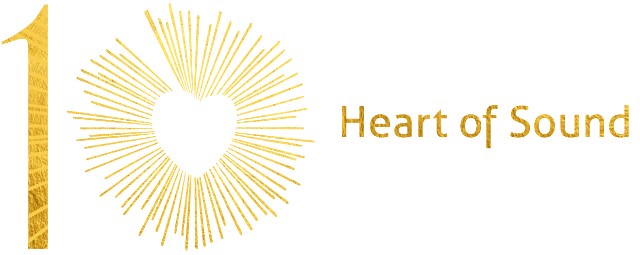The Healing Power of Voice

In this interview by Jeff Greenwald for The Nine Gifts, Anandra speaks about the Healing Power of Voice.
Jeff Greenwald:
We begin to control the sounds we make when we are babies—but when and why do we actually start singing?
Anandra George:
That's a wonderful question—but not being a developmental child psychologist or child linguist, I can't answer that with any kind of authoritative stance. But I can answer from my own perspective.
When I was a child, my mother told me that I was humming to myself all the time. She would always ask me, "What are you singing? What are you doing?" And I was like, "I don't even know what you're talking about. I'm not singing." I was just humming to myself, probably little melodies, maybe even just sound. And for me, it was a self-connection. It was a way to find a home base in myself when I was surrounded by a lot of trauma, domestic violence, and alcoholism. So for me, it was survival.
Jeff Greenwald:
Moving to a place within yourself.
Anandra George:
Yes. I think looking back on it now, with what I know about sound as a medicine, it's very clear to me that I was intuitively humming to use my voice, and the sound of my own voice’s vibration, as a way of self centering. I mean, I could also answer in the direction of, "We sing for joy and we make songs out of celebration for nature, and we imitate the birds." I could go in that direction as well, which is also true.
Jeff Greenwald:
I'd like to pursue a phrase you just used: “Sound as a medicine.” What do you mean when you say that?
Anandra George:
Again, I could answer from a whole bunch of different perspectives, starting with the nervous system. When we think about medicine, we think about healing; and healing is the body's own regenerative response. Rest, digest, repair, are the parasympathetic nervous system. And sound—especially the sound of our own voice—can bring us there.
When we sing, the exhale is typically longer than the inhale. And that’s one way to increase your vagal tone—which is the measure of how quickly you can switch from a state of “fight, flight, freeze” into “rest, digest, repair.”
Along with the long exhale, the vibration of the voice actually touches the vagus nerve, which runs through the back of your spine into the base of your skull. So stimulates—a sonic massage, if you will—the top end of the vagus nerve. And the health of that nerve, the ability for the vagus nerve to respond quickly, is called the vagal tone.
So from that point of view, sound is medicine, in the sense that singing out loud has direct, and widely documented, nervous system health benefits. And I could also mention the metaphor of “finding your voice,” and “using your voice.” It’s very healing to feel you have a sense of agency; the ability to create your world through your voice.
Because we know that in trauma, one of the first things that happens is that the throat closes up. Once you stop feeling that you can say “no,” you choke up. You choke your words, you choke your truth, you choke your call for help. And if you can't call for help, or you try and nothing happens, you lose a sense of connection to the power of your voice. So singing, and using your voice in a conscious way, helps you recover your voice—in a very profound and personal sense.
Jeff Greenwald:
What an incredible, great answer. Here is what may be a related question: What is a mantra?
Anandra George:
When people ask me what a mantra is, I don't have a pat answer. A simple translation of the word is, “that which protects from the ordinary mind.” A Sanskrit mantra is a collection of syllables that you repeat to resonate a particular vibration, which helps to anchor you in a state of consciousness or vibratory awareness. You might say it’s a tool of the mind; a repetitive affirmation of our eternal nature versus self-sabotaging or reactive thoughts.
Jeff Greenwald:
I know many people are given mantras at retreats or at ashrams, but how do you attain or create your own mantra?
Anandra George:
There are specific traditions of mantras. But because The word “mantra” has been co-opted in our general culture, people use it without understanding what the word actually indicates.
In order to understand the Sanskrit mantras, you need to understand the vibrations of the letters that make up the mantras, and understand the grammar of the Sanskrit. So you wouldn't make up your own Sanskrit mantra without that knowledge. For example, people say "The universe is conspiring for my happiness," as if that were a mantra. But it's not; it's an affirmation. To me, that definition is important.
Jeff Greenwald:
How can one attain a mantra, if they can't invent one for themselves?
Anandra George:
Well, the beauty of the Sanskrit mantras is the weight of tradition, in a sense. There's a deep, profound, continuous, unbroken line of mantras that have been chanted continuously for thousands of years. Those mantras have a tangible subtle substance to them. They have a resonance that's prepacked with potency, and those are the mantras which are commonly done today.
So, basically, I'd say you can get some training on how to pronounce those mantras which are commonly available. Start using one, and see how it feels.
Jeff Greenwald:
If there's an online resource for that at all, could you please send me a link?
Anandra George: My website www.heartofsound.in has a wealth of resources, including blog posts with links to other reputable sources of information.
Jeff Greenwald:
Maybe you've already addressed this, Anandra, but what is the neurological value of a mantra?
Anandra George:
I do have one low-hanging fruit to offer here. My friend, Dr. Hemant Bhargav, of The National Institute of Mental Health in Bengaluru, India, had done some studies in an fMRI machine on the mantra “Om.” He was able to determine, through these fMRI scans, that the test subjects who chanted the Om mantra showed limbic deactivation. It actually calms your “fight, flight, freeze” response. Other studies are being done, such as Gemma Perry’s PhD research in Australia. https://www.abc.net.au/news/2020-04-21/chanting-practice-reduce-symptoms-stress-anxiety-depression/12046736
Jeff Greenwald:
Can listening to music, or to singing, be as good an intervention as creating it?
Anandra George:
Though I don't think you can say that one’s better than the other, I would say that they serve different functions. Listening to music can be a passive healing method for those times when you just need to receive, and/or you just don't have it in you to have a creative, active engagement in your healing. But creating music and participating actively in rhythm and tone and harmony and melody, and singing - using your own body as an instrument to create the sound vibrations that you want to hear - is another level of intervention altogether. Active participation creates a profound sense of agency and dozens of specific transformative effects.
But obviously I'm a little biased, because I love teaching non-musicians how to make music at any age!
Jeff Greenwald:
What's the first thing you teach them?
Anandra George:
How to listen. How to listen, and hear what they're hearing.
Jeff Greenwald:
In general, out in the world? Or musically?
Anandra George:
I start musically, because through music we can learn the listening skills that help us listen in other areas of our lives. The great mystical tradition of Indian music is a wonderful way to start, because there's one note that is the home base note. It's called the sa. Sa is your home note. So you start by listening in, leaning in to sa. You listen, and you merge your consciousness, your mind, your breath, your body, your voice, with sa. Once you feel at home in the listening, then you explore other notes slowly and create a spontaneous melody; you feel the movement of the tone going out of sa.
Jeff Greenwald:
Do you think different genres of music, like jazz or classical, have different neurological effects on people when you're listening to them?
Anandra George:
Certainly, it would be logical that they would. Again, I'm not an expert on that. But I can answer from an Indian musician's perspective.
Jeff Greenwald:
Okay.
Anandra George:
Indian classical music is based on rāgas. There are hundreds of them—and each rāga is considered almost a different world. Each evokes a very particular flavor of embodiment, of emotion, of resonance and vibration. We're not talking about different styles all together; we're talking about patterns of notes, and the incredible difference in effect that these different patterns have on the consciousness and the being. If that doesn't somehow map neurologically, I would be shocked.
Jeff Greenwald:
You’ve noted that, while people are attracted to harmony, we can use dissonance to explore our discomfort into the unknown. Can you elaborate on that?
Anandra George:
Yes. That's also something I've learned from Indian music—because we take the approach of starting with sa, then slowly getting to know the other notes, going up and down. You get to know, very intimately, how there is tension and release in the patterns of the notes. That dissonance is a gateway; it penetrates into the mystery. And it is uncomfortable. If you stayed there for a long time, it would irritate your nerves. But sometimes, we need that irritation or agitation in order to break on through to the other side of something.
In our Western ear, we're drawn to melody, and major chords. Are we drawn to it because that's all we've ever heard? Or is that somehow just natural? I don't know. But the sense of using dissonance as a penetrating force for change is something that great composers do, and movie score people do, jazz musicians do, and certainly Indian musicians do.
In Tantra, also, you don't give preference to the pleasant. You stretch to embrace the unpleasant and the uncomfortable, because it's all part of nature’s plan. So as a musician, it's important to listen in to the discomfort and use dissonance wisely.
Jeff Greenwald:
What can people do right now to use singing to change their state of mind?
Anandra George:
In this pandemic moment right now, we are in such a time of panic and uncertainty and change. There's a maybe unprecedented level of fear and uncertainty at this moment—in my lifetime, anyway.
I would say that right now, humming to yourself when you feel anxious or stressed or depressed or lonely or disconnected is a great start. Just, “mmmmmmm" to establish connection with yourself and turn your focus inward. Feel the vibration of your voice spreading through your body. Befriend your voice. It can be a kind of home base; a source of nourishment and peace that gives you the safety to listen. It calms your nervous system and gives you the safety to be able to feel what you're feeling, and not run away from it.
Jeff Greenwald:
That's great. Thank you, Anandra.
The Nine Gifts: A First Aid Kit for Mind, Body and Spirit by Christine Marie Mason, with Jeff Greenwald is available now.


